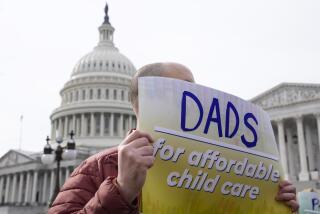Day-Care Responsibility Lies With States
- Share via
In 1971 the White House Conference on Children identified child care as the nation’s No. 1 problem. Nearly two decades later more than 60% of the mothers in this nation work outside the home. Despite hundreds of thousands of children in day care, current U.S. policy does not support high-quality infant, toddler or preschool day care; does not have a uniform standard for the day-care facilities that do exist, and ignores the needs of school-age children who require before- and after-school child care.
We have a big child-care problem in this nation, but no one is acknowledging its magnitude or cost. By the year 2000, 75% of all mothers are expected to be in the labor force. Who will be caring for their children? This nation currently has a two-tier system of child care--one for the rich and one for the poor. The rich are purchasing quality care. But many parents are forced, by cost considerations, to put their children into environments that are harmful to their development.
There is no national policy on day care, and no federal standards aimed at establishing a system of care that is of good quality. Child-care proposals being discussed in Washington are grossly inadequate. Quality child care for America’s children will cost $75 billion to $100 billion per year. (The cost of individual infant care is approximately $125 per week; for preschoolers, $45 to $75 per week.) The Alliance for Better Child Care (ABC) is requesting only $2.5 billion in federal subsidies. ABC, which is made up of 65 organizations and is spearheaded by the Children’s Defense Fund, appears to have the most politically viable child-care plan.
Child care should not be the responsibility of the federal government; it should be a state responsibility. Just as individual states are in charge of education, so, too, should states be in charge of child care. The federal government’s role should be limited to research, disseminating the knowledge of child-care experts, offering subsidies to the poor and/or handicapped and providing a leadership role for the states.
The problem of child care has existed for too long, and it is too critical to be left to federal initiatives. Parents who need to work cannot wait year after year for Congress to appropriate funding for child care. Parents cannot depend on the churches or big business to assist with child care as some advocates have suggested. The churches have neither money nor expertise. Of the more than 6 million employers in this nation, Sen. Christopher J. Dodd (D-Conn.) has noted that fewer than 3,000 assist employees with child care.
Despite the money needed for quality care, and the fragmentedsystem that currently exists, there is a solution to this problem.By utilizing neighborhood school buildings for on-site child care, we can create the school of the 21st Century. The neighborhood elementary school buildings can be used for two purposes: formal education for 5-to-12-year-olds, and a second system within the school that provides on-site child care for 3-to-12-year-olds before and after school, and full-time care during vacations. A more efficient use of the buildings would keep the effect of adding the 3- and 4-year-olds to the system to a minimum. The school of the 21st Century will be equitable, affordable, reliable, of good quality and built into the fabric of society.
In addition to on-site care, three outreach programs will be provided by this second system: a family support system for first-time parents; a support system for existing private day-care homes within the neighborhood, where most of the children under age 3 are currently being served, and information and referral services.
This second system will be run by child development associates working under the direction of an early childhood educator. Educators will continue to run the formal teaching component in schools as they do today, and this schooling will continue to be funded by taxpayers. The child-care system will be paid for by those who choose to use it. Fees will be based on family income and ability to pay.
The federal government should select 60 schools, at least one per state, and fund these schools of the 21st Century on a demonstration basis. After the program is in place, the federal government should assist states to produce more and more schools of this type.
We cannot expect parents to work and be productive if they do not know who is taking care of their children. The child-care problem is not simply one of parental peace of mind, of productivity and a healthy economy, but is also one of the care and nurturing of our next generation. We must institutionalize quality child care. Our society and our place in the world depend on it.
More to Read
Sign up for Essential California
The most important California stories and recommendations in your inbox every morning.
You may occasionally receive promotional content from the Los Angeles Times.













